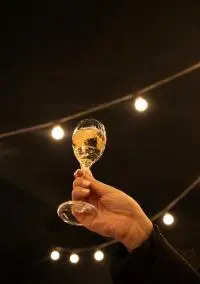3-steps tasting
Sight, smell and taste.
Tasting Loire wines calls on your senses, especially sight, smell and taste.
Looking at the wine's color, smelling its bouquet and then tasting it, these are the 3 steps of wine tasting!
Step #1: look
Step #2: smell
Step #3: taste
The eye for the dress
With your glass of Loire Valley wine on the table, you can assess the wine's color:
Exact color:
- Loire Valley white wines can be dry and semi-dry, mellow or even syrupy. They come in a wide range of yellows: green, lemon, straw, golden or amber.
- Rosé Loire wines come in many shades of pink: gray, peony, salmon pink, raspberry, cherry, orange.
- Red Loire wines vary in hue according to grape variety and vinification. They can be purplish red, cherry, ruby, garnet, purple, brown, black or even
oiled.
Intensity: light or pale, light, medium, sustained, dark, dense, deep.
Brightness:vivid, frank, shiny, brilliant, dull, matte, oxidized, worn, faded.
Limpidity:cloudy, louche, hazy, veiled, clear, bright, crystalline, with or without deposit.
Fluidity:fluid, thick, dense, oily, viscous.
Take your glass of Loire wine by the leg
Light it gently to observe the nuances of its robe, gently swirl the wine in the glass to observe the "legs" or "tears" that will give you an idea of the wine's consistency: rather fat and concentrated, or rather fluid and light.
Then it's time to smell the wine!

The nose for the bouquet
The nose, an indispensable organ of taste!
Plunge your nose into your glass of Loire wine, sniff, inhale, take a breath and try again. You'll perceive subtle, powerful, fresh, pleasant scents... or unpleasant ones if the cork has played a nasty trick on the wine.
All these aromas may evoke in you a scent of flowers, a fruit dessert , a baked brioche, your grandfather's tobacco joke, the spices of a previous dinner, a mushroom gathering and many more that you'll spontaneously associate with your memories, places, people, emotions.
You'll be able to find aromatic nuances:
- flowers (white, rose, violet, acacia, elder, lime)
- fresh fruit (apricot, citrus, banana, red fruit)
- dried fruit (walnut, hazelnut)
- confit fruit (fig, orange peel)
- vegetal (grass, fern, hay)
- undergrowth (mushroom, earth, humus)
- animals (meat, leather, amber)
- empyreumatic (toast, coffee, burnt wood, earth, sulfur, tobacco)
- balsamic (vanilla, thyme, pine resin)
- wood (casks, green wood)
- spices (cinnamon, clove, pepper, honey)
- minerals (flint, flint, iodine).
Then it's time to taste the wine!
The mouth for taste
From a quickly gulped Loire wine you will have seen nothing, smelled nothing, retained nothing.
What could be more pleasurable than pouring yourself a glass of wine and enjoying every sip? Is your wine gourmand like a cabernet-d'anjou or a coteaux-du-layon, vivid and fresh like a muscadet, supple like a saumur-champigny, elegant and refined like a savennières or anjou-blanc, light and fruity like a touraine, sparkling like a crémant-de-loire or saumur-brut, round like a chinon? It's by rolling the wine around in your mouth, chewing it with your tongue according to custom and making an effort to pay attention that you'll be able to enjoy it to the full.
Once the wine has been swallowed, or spat out, just a little more attention: you'll be able to tell whether the wine is long on the palate or short, i.e. whether its flavors and aromas fade quickly or bloom for a long time.
Even with very little experience, you'll be able to evoke what odorous notes are expressed between the back of the throat and the nose, what the nature of the tannins is: whether they're soft on the palate, silky and supple, and whether your sensation is pleasant.
Comparing the odor and aroma of the same wine makes tasting richer and more interesting: you'll come to better grasp all the facets of the product.
To remember!
Remember that it's your own sensations that come first!
The imprescriptible rights of the wine drinker (all in moderation, of course!):
Right not to drink
Right to like, even the amiable vacation piquette.
Right not to like, even that prestigious magnum we were saving for Anne-Sophie's wedding.... It would have been better to open it for her communion.
The right to defend one's opinion, especially against an illustrious taster.
The right to spit it out, sometimes even a duty...
The right to empty the bottle into the sink or the green plants.
Right to taste alone, even if it's better with several people...
Right to grumble about cork taint, even if the winemaker can't do anything about it.
Right to make noise while tasting, but no need to rouse the whole restaurant with gargles.Les Vins de Loire wish you happy tasting!

